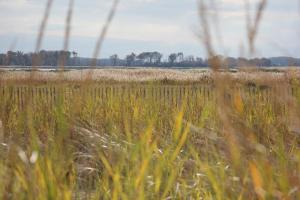Carper, officials visit Prime Hook
Delaware Sen. Tom Carper and wildlife officials visited Prime Hook Refuge Oct. 22 to get a close up look at a beach restoration project that began five years ago.
“Prime Hook offers a true success story in both habitat conservation and resilience. We should all be proud of the work by [the U.S.] Fish and Wildlife Service to protect threatened and endangered species in our refuges and prevent new species from becoming endangered,” Carper said. “Maintaining our refuges proves to be an excellent model for not only protecting the species we hold dear but also boosting local tourism across the country – a true win-win.”
Carper was joined by officials with the U.S. Fish and Wildlife Service and the National Wildlife Refuge System and they toured Fowler Beach and the coastal habitat of Prime Hook Refuge.
Five years ago, Prime Hook National Wildlife Refuge underwent a large-scale tidal marsh restoration/mitigation project in its wetlands. A parking lot that once went to the beach was eliminated, allowing for dune grass and sand to cover a larger coastal area. Carper said the project was one of the largest marsh restoration projects ever completed in the eastern United States.
In 2017, the American Shore and Beach Preservation Association named Prime Hook NWR beach one of the five best-restored beaches in the nation. Today, Prime Hook is regularly visited by bird watching enthusiasts.
Melissa Steele is a staff writer covering the state Legislature, government and police. Her newspaper career spans more than 30 years and includes working for the Delaware State News, Burlington County Times, The News Journal, Dover Post and Milford Beacon before coming to the Cape Gazette in 2012. Her work has received numerous awards, most notably a Pulitzer Prize-adjudicated investigative piece, and a runner-up for the MDDC James S. Keat Freedom of Information Award.





























































